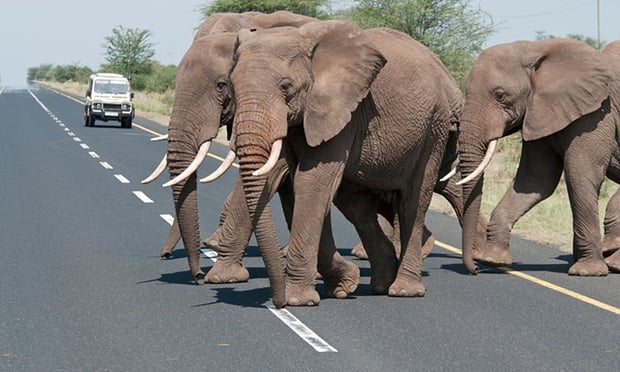Many new road and rail ‘‘development corridors’’ planned to crisscross Africa in the name of economic development could destroy the continent’s equatorial forests and savannahs, lead to many people invading protected areas and have only limited chances of increasing agricultural production, say scientists in a new study.

A road near Ngorongoro, Tanzania. A number of proposed development corridors would have a serious impact on wildlife, according to the authors of the study. Photograph: Laura Romin & Larry Dalton/Alamy
If built, the 33 giant transport routes, some of which will be 3,000km-long, will open up the African interior to farming and trade and are likely to attract large-scale immigration, including legal and illegal miners, commercial agricultural interests, and people seeking newly accessible farming or grazing areas, according to the report, published in the journal Current Biology.
The danger, say scientists, is that illegal logging could devastate some of the last great forest areas, and hundreds of thousands of square kilometres of sparsely populated but biologically rich areas in east and southern Africa would be damaged irreparably.
They say: “Africa is changing faster than any continent has ever changed in human history. A key priority in the coming decades will be increasing agricultural production and efficiency to improve food security and alleviate poverty for Africa’s rapidly growing population while harnessing the unprecedented scale of foreign investments focusing on land and natural-resource exploitation.”
The proposals range from building, or upgrading, major roads and railways across the Congo basin and east-west links in southern Africa. One route is planned to link Dakar in Senegal to Port Harcourt in the Niger delta. Another would eventually link Kenya with Chad.
If all the corridors identified by the authors are built, they would total 53,000km in length. Most involve roads, rail, powerlines and pipelines and each would probably lead to development at least 50km-wide along their length.
“Africa needs better roads and railways which, if well located, can do a lot of good but if badly sited can open a pandora’s box of problems, as has occurred in the Amazon where illegal logging and poaching of wild animals has devastated pristine areas,” says Professor William Laurance, an ecologist at James Cook University, Cairns, Australia, and the study’s lead author.
Laurance said Africa’s development corridors would strongly affect future patterns of mining, land occupation and agriculture. “Our analysis suggests that, as currently planned, a number of the development corridors would yield only limited agricultural benefits while severely degrading African ecosystems and wildlife. Concerted efforts are needed to reduce and mitigate these impacts.”
Six of the corridors are said to be well planned with large benefits and only limited environmental costs, another six risk damaging critical environments, especially rainforests in the Congo basin and west Africa and biologically rich equatorial savannah regions, according to the study.
But the author argues that the 20 or so marginal corridors should be evaluated in much greater detail. “If they do progress, it should only happen under the most stringent conditions.
“For Africa, the dangers of the development corridors are profound. Even if well executed, we estimate that the current avalanche of corridors would slice through over 400 protected areas and could easily degrade another 2,000.
“Beyond this, the corridors will encourage human migration into many sparsely populated areas with high environmental values. The wild card is the hundreds of billions of dollars of foreign investments pouring into Africa each year for mining. Even if a corridor is likely to yield only modest benefits for food production it may be very difficult for governments and decision-makers to say no to big mining investors.”
Click here to read the original article.
